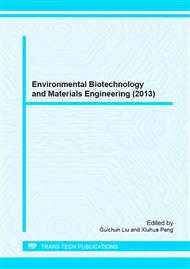p.430
p.434
p.440
p.444
p.449
p.453
p.457
p.461
p.467
Study on Removal of COD in Horizontal Subsurface Flow Constructed Wetlands by Regression Equation
Abstract:
At present the majority of studies on constructed wetlands reports are limited to a single wetland and hence the results lack broad representation. In order to study the general effect of treatment of sewage using a horizontal subsurface-flow constructed wetland, a more detailed wetland regression equation needs to be established to guide the design of constructed wetlands. In this study, we used the main pollutant index COD as the indicator and classified 1500 groups of collected data in accordance with the season, hydraulic loading, planting vegetation type and climate type classification in accordance with the "black box model". We analyses different factors affecting pollutant removal by constructed wetlands, using the impact of season and hydraulic loading as the main classification criteria. On this basis, in accordance with the linear regression method, 12 groups of regression equations for COD removal were established. The goodness of fit R2 values ranged from 0.65 to 0.95, showing the accuracy had been greatly improved. Using the regression equation in the design process can better estimate the removal effect.
Info:
Periodical:
Pages:
449-452
Citation:
Online since:
September 2013
Authors:
Price:
Сopyright:
© 2013 Trans Tech Publications Ltd. All Rights Reserved
Share:
Citation:


